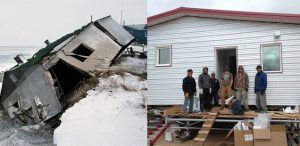Elizabeth Arnold at the Shorenstein Center of Harvard University:
 In July of 2008, as a national broadcast correspondent, I reported on environmental conditions in Newtok, a remote community of roughly 400 Yup’ik people in Northwest Alaska. Newtok was losing forty to a hundred feet of coastline a year to erosion, and sinking because of “permafrost” that is no longer permanent, the direct result of a warming climate. Flooding threatened homes, the school, and the only supply of clean water. I chose to report on Newtok because the community was actively working on a relocation plan after voting to move to higher, more stable ground. My story compared the actions of Newtok with Kivalina, an Inupiaq community of the same size situated on a barrier island further north. Kivalina faced similar conditions and had filed suit that same year against ExxonMobil Corp. for damages caused by climate change.
In July of 2008, as a national broadcast correspondent, I reported on environmental conditions in Newtok, a remote community of roughly 400 Yup’ik people in Northwest Alaska. Newtok was losing forty to a hundred feet of coastline a year to erosion, and sinking because of “permafrost” that is no longer permanent, the direct result of a warming climate. Flooding threatened homes, the school, and the only supply of clean water. I chose to report on Newtok because the community was actively working on a relocation plan after voting to move to higher, more stable ground. My story compared the actions of Newtok with Kivalina, an Inupiaq community of the same size situated on a barrier island further north. Kivalina faced similar conditions and had filed suit that same year against ExxonMobil Corp. for damages caused by climate change.
In the decade since my report aired on National Public Radio, news outlets from all over the world visited Newtok, Kivalina, Shishmaref, Shaktoolik and a dozen other Alaska Native communities forced to consider relocation because of the effects of climate change. The national stories all fit the same narrative pattern. With images of houses tipping precariously off cliffs, and phrases such as “impending doom,” and “cultural extinction,” the reporting paints a picture of tragedy and hopelessness, framing community members as victims to sell the urgency of mitigation to the public. As a CNN correspondent unabashedly reported, “a trip here is like a trip into a disturbing future.”
The repetition of this narrow narrative in national and international media for more than ten years has not resulted in a groundswell of support for mitigation or adaptation. Nor has it resulted in public policy at the state or federal level. It may have even undermined the ability of these coastal communities to help themselves.
More here.
